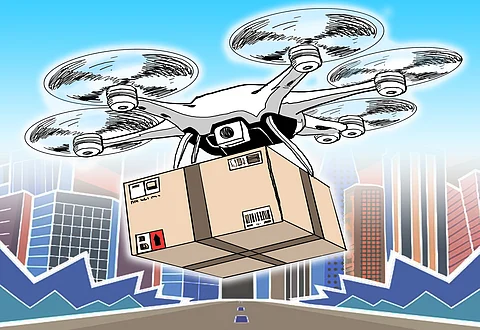
- NEWS
- the EDIT
- COMMENTARY
- BUSINESS
- LIFE
- SHOW
- ACTION
- GLOBAL GOALS
- SNAPS
- DYARYO TIRADA
- MORE

The idea of drones zipping through Metro Manila skies, bypassing traffic jams and delivering goods with sci-fi precision, is understandably exciting.
Grab Philippines’ pilot program for drone-assisted commercial delivery has certainly piqued the public interest. According to the plan, aerial drones will handle mid-route transport while delivery partners will pick up and drop off packages at designated drone landing stations.
It’s a promising vision of the future — but is it truly feasible in the chaos and complexity of Metro Manila?
On the surface, the benefits seem compelling. Anyone who has spent more than an hour stuck in EDSA traffic knows that the metro’s overburdened roads are choking traditional logistics. Even motorcycle deliveries, while nimble, are not immune to bottlenecks, erratic weather and increasing demand.
Aerial drones can soar over all that gridlock, reducing travel time for packages and potentially revolutionizing last-mile logistics. Faster deliveries will mean happier customers, lower fuel costs and perhaps even a lower carbon footprint. What’s not to love?
Well, reality might clip the wings of this high-flying idea.
First, there’s the issue of infrastructure. For the pilot to succeed, Metro Manila must establish a network of drone landing stations that are secure, accessible and ideally free from interference.
In a densely packed urban jungle where every square meter is contested, finding suitable sites — especially close to residential areas and businesses — will be challenging. Will malls host landing pads on their rooftops? Will barangays cooperate to install them in open fields or parks? And who will maintain them?
Second, airspace regulation poses a major hurdle. The Civil Aviation Authority of the Philippines (CAAP) currently has strict rules about unmanned aerial vehicles (UAVs), especially when flying over populated areas. Drones may be subject to altitude restrictions, require line-of-sight piloting, and must avoid airports, government buildings and no-fly zones.
Add to that the security concerns: unauthorized access, hacking risks and accidental crashes that would spell disaster in crowded neighborhoods.
Then there’s the weather factor. Unlike motorcycles that can ride through light rain, drones are grounded by adverse conditions — heavy rain, strong winds and high temperatures could disrupt operations. In a country known for its volatile weather patterns, this could result in frequent cancellations and inconsistency in service.
Moreover, cost is a concern. High-tech drones capable of carrying commercial payloads over long distances aren’t cheap. Neither is the tech stack needed for real-time monitoring, AI-powered navigation, and anti-collision systems. Would consumers be willing to pay a premium for drone-speed delivery? And will small businesses be able to afford to participate?
That said, a hybrid system, like the one Grab is proposing — where drones handle mid-route flights between hubs, while riders manage door-to-door delivery — makes a lot more sense. It avoids the complex problem of drones landing directly on doorsteps or maneuvering around tangled power lines. It also supports jobs creation by keeping human riders in the equation.
As a whole, drone delivery in Metro Manila is not pure fantasy, but it’s far from a plug-and-play solution. The idea is feasible — with conditions. A successful pilot would require close coordination among government agencies, private companies and local communities. It would need solid infrastructure, updated regulations, robust contingency plans and realistic expectations.
If done right, drones could become the new workhorses of urban delivery. If done wrong, well, Metro Manila will just add “drone crash traffic” to its already colorful problems.
